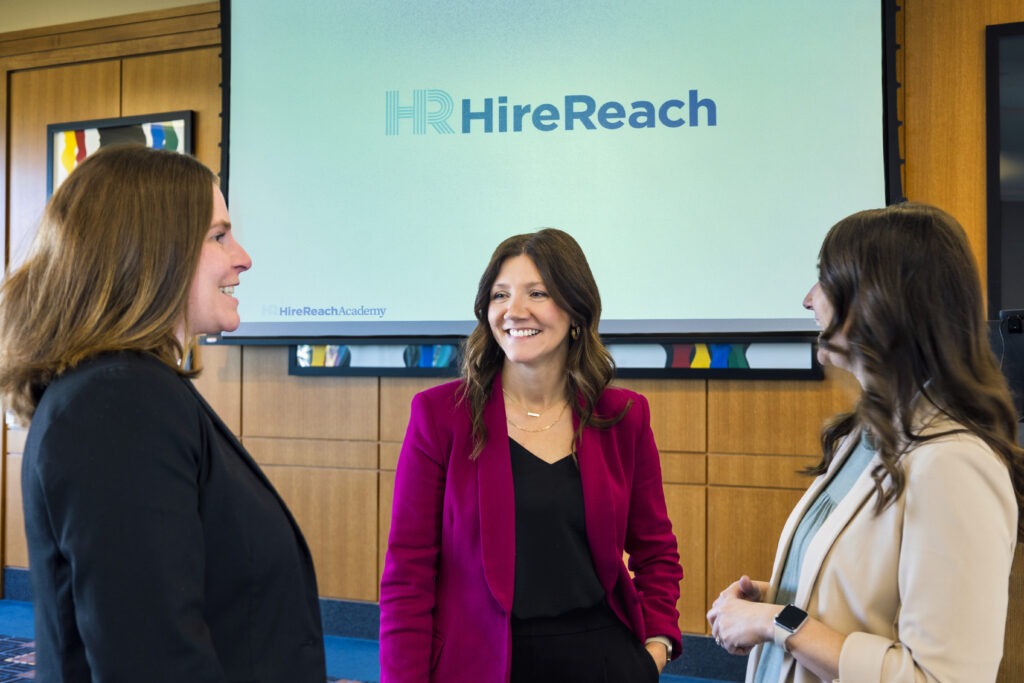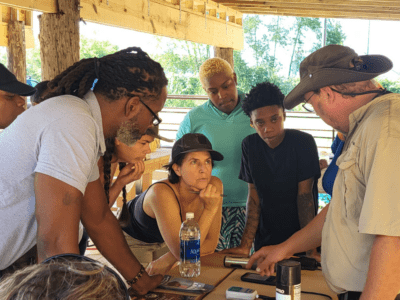Photos by Isabel Lopez Slattery
In 2010, Trinity Health in West Michigan was struggling with staff turnover. While they had multiple openings across their hospital and health care systems, they just weren’t finding people who wanted to stay in the jobs.
“We saw that as an opportunity to try something different … to try what we used to call the evidence-based selection process,” says Shana Lewis, vice president of Talent Acquisition and Workforce Development Programs at Trinity Health.
When they began the program they looked to improve some key metrics, including reducing the time it took to fill vacancies and lowering first-year turnover rates. “At the time we weren’t really after increasing the diversity of our workforce, although that’s always been a lens for us at Trinity,” Lewis explains. “But we were more focused on not having an adverse impact on certain populations through the use of this process.”
In other words, Lewis and her team were looking to remove bias from the hiring process, something companies across the country have been struggling to figure out for decades.
According to a 2006 study from the Journal of Organizational Behavior and Human Decision Processes, a job interview is the perfect setting for subtle cues and perceptual and judgmental biases to affect decisions in the hiring of an individual. Subtle cues – like having an accent when speaking English – have an adverse effect on whether an individual is hired. Minimizing some of that harm was the motivating goal for Lewis and her colleagues.
“We’re human beings,” Lewis said. “So we often bring those unconscious biases to work with us.”
And when you don’t have a fair objective process in place, at the very beginning of the selection process, some of that unconscious bias can creep in.”
Implementing the evidence based selection process, Lewis says, meant revamping their entire hiring process. Instead of solely focusing on a resume, they began using an assessment, two interviews and a reference check to come up with one score for an applicant.“We do look at resumes, but we also know people are not resume writers.… Most people that will apply, that have any level of work history or any applicable experience to the role, we’ll set up a phone call with a member of the talent acquisition team,” she said.
The phone calls help provide a holistic view of the job applicant – one they couldn’t have gleaned from considering them only through their resume. “So we’ve eliminated, in some cases, degrees that were a part of a job description in the past that we realize now aren’t really relevant to the role,” Lewis added.
This change allowed Trinity Health to consider candidates who didn’t have a degree from a higher education institution but did have the experience to match that educational background. They’ve also started to flip their process and consider candidates who only have 20% of the experience they are looking for instead of 80%. “These individuals are motivated to gain that training, so we ask ourselves what we can do to ensure that they are successful in a role where they will need that additional training,” she said.
This model, Lewis says, has proved successful. One unintended outcome from the process so far is that people of color have made up over 20% of those being hired into the hospital system. Hearing about this success is what motivated Tracie Coffman, program officer at the W.K. Kellogg Foundation, to get more than involved – to help Trinity Health scale this program outside of the hospital system.
“How can we show that this isn’t just a Trinity Health program, that it’s something that actually multiple employers could do in multiple sectors, that it doesn’t just live here,” she said.
By partnering with the Doug & Maria DeVos Foundation, W.K. Kellogg Foundation funded West Michigan Works! to use the evidence-based selection process Trinity Health developed in other sectors. Today that program is known as HireReach, and it focuses on helping employers across the region implement evidence-based selection to improve the accuracy of and reduce bias in candidate selection decisions.
“The process to assess people’s skills, and then to assess the job and what skills the job actually needs, removed a hiring manager’s gut feeling about whether or not a person fits into the role, because there were now more objective measurements of whether or not they have the skills to fit into the role,” Coffman explains.

HireReach project manager Marlene Brostrom (center), with two attendees at a 2023 conference.
At HireReach, project manager Marlene Brostrom strives to provide employers a broader perspective of a potential applicant. Using personality and cognitive assessments and interviews focuses on understanding the applicant’s behaviors instead of just their previous job experiences.
“We do not advocate for cutoff scores. Instead, we collect data on the applicant’s personality to really see how good of a fit this person is compared to the job and then determine what competencies we really need for someone to be successful at that job,” she said.
Brostrom says they want the employer to realize they can find a perfect fit for positions in individuals they never thought they could. The City of Grand Rapids was one of the first organizations outside of Trinity Health to use the model of HireReach to rethink their hiring practices, where they tested out the program in filling a customer service clerical role at the city. Through HireReach, the City of Grand Rapids ended up hiring someone who primarily had experience as a bus driver and who wouldn’t have advanced further in the hiring process if the city had utilized former hiring processes.
Because the City looked at [the applicant’s] personality and their skills, they realized they were the perfect fit for the role,” she said.
“This individual spends countless hours talking to customers as a driver, they were already adept at multitasking.… inevitably they already had the skills needed for this customer service role.”

Michelle Nichols-Eddie (left), assistant director of human resources for the City of Grand Rapids, with Desireé Frugé, director of human resources.
Desireé Frugé, Director of Human Resources at the City of Grand Rapids, says implementing this model was about making the hiring process more equitable and fair. Before using this process, Frugé says they asked applicants to take a civil service exam to determine if they had the skills necessary for the job – but often these tests weren’t written at the educational level the job description required. “If we say this is a high school diploma job … are we really testing at that level?” Frugé explained.
Instead of using the civil service exam to determine if a candidate passes or fails, they now use cognitive assessments to determine how closely the candidate aligns with the position. “I think there’s just been a group of people that’s been boxed out of employment,” Frugé says. “And now I think we have the tools to make employment decisions and to set people up to be successful.”
Through HireReach, Frugé says she wanted to get away from a hiring process where a candidate is hired simply because they make the interviewer feel good. “It’s been a great opportunity for me to provide that to people that are candidates coming into the city,” she adds.
Now the city is working to use HireReach to help employees advance through higher paying positions. “We are using career coaching tools learned through HireReach to help support employees in their current roles or find better fits for them within our organization,” Frugé said.
As Frugé is getting ready to retire from her position as Human Resource Director, she says bringing on HireReach to the City of Grand Rapids is one of the decisions she’s most proud of in her decades-long career.
To date, 41 organizations, including businesses, corporations, nonprofit organizations and several government entities in and outside of West Michigan, have utilized HireReach.










Comments